Encinitas Landscape Transformation Project Wins Local Contest
Encinitas, Calif.—Olivenhain Municipal Water District’s Board of Directors honored at its September 9 meeting Laura Lisauskas as the winner of OMWD’s 2020 Watersmart Landscape Contest.
Encinitas, Calif.—Olivenhain Municipal Water District’s Board of Directors honored at its September 9 meeting Laura Lisauskas as the winner of OMWD’s 2020 Watersmart Landscape Contest.
Encinitas, Calif.—Olivenhain Municipal Water District’s Board of Directors recognized the winners of the 2020 North County water agencies’ Water Awareness Poster Contest at its September 9 meeting.
Reservoir Keeper Viviana Castellon shared her expertise with citizens during the City of San Diego’s #AskAnExpert series on Instagram as part of the City’s community outreach to citizens. The City regularly offers the opportunity for the public to ask employees about its services including parks, libraries, streets, and water.
“We find that it’s a great way to get general information about City services to the public,” said Arian Collins, public information officer with the San Diego Public Utilities Department.
Castellon answered several questions about the recreation offered at the City’s lakes and reservoirs.
Can you rent boats at City of San Diego reservoirs?
Yes, the reservoirs do have boat rentals through the concessionaires. You can view the hours of operation and rentals fees online.
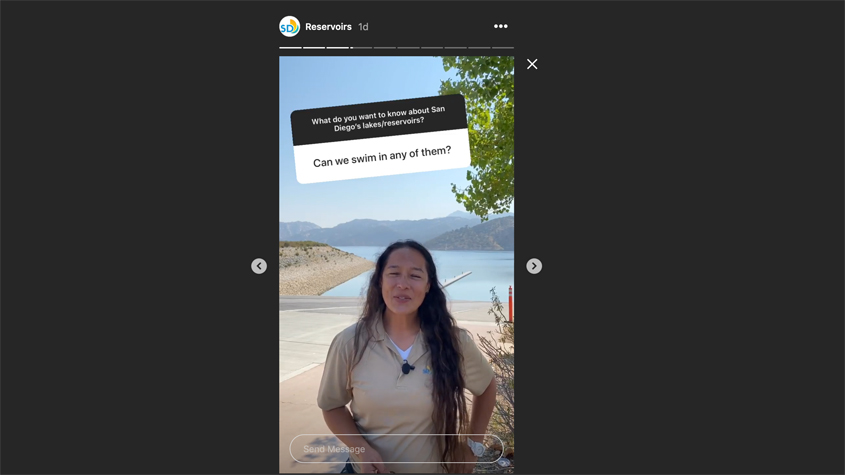
Social media outreach gives City of San Diego residents access to experts like Reservoir Keeper Viviana Castellano. Photo: City of San Diego/Instagram
Is stand-up paddleboarding allowed at any City of San Diego reservoir?
Yes, Hodges Reservoir offers stand-up paddleboarding on Wednesday, Saturday, and Sunday from the beginning of February through the end of October.
Can you swim at City of San Diego reservoirs?
No. What are commonly referred to as the San Diego City lakes are actually impounding reservoirs that are part of the City’s municipal water-supply system. The State Water Resources Control Board approves the different recreational activities that can occur on our reservoirs and swimming is not included in our current domestic water supply recreational permit.
Can you water ski at the City of San Diego reservoirs?
Yes, San Vicente Reservoir offers water-skiing and wakeboarding from May through October Thursday through Sunday.
Residents who would like to keep up with the latest information about the City’s reservoirs and lakes as well as other City of San Diego services can learn more at the City of San Diego website, as well as follow the City’s Instagram account for more #AskAnExpert opportunities.
With the recession and the COVID-19 pandemic causing economic havoc nationally and across Southern California, the San Diego County Water Authority has adopted several cost-cutting strategies to reduce rate increases and it’s asking the Los Angeles-based Metropolitan Water District of Southern California to do the same.
When the Water Authority’s Board of Directors approved its 2021 rates in June, it limited rate increases to 4.8-4.9% – and more than 60% of that rate increase is directly attributable to MWD. The Water Authority Board also directed staff to return this fall with any other cost savings, specifically, any pass-through savings from MWD.
So far, MWD’s Board has directed agency staff to look for cost-cutting measures – but MWD staff is proposing not to offer further rate relief. Even though MWD is proposing to initiate cost-containment efforts to save $11.7 million in FY2021 (less than 0.6% of its budget), MWD’s September rate review memo recommends not to incorporate the savings into its budget and not to offer rate relief because it found member agencies “have not experienced significant [financial] impacts attributable to COVID-19.”
In reality, San Diego County and the nation continue to face a recession and double-digit unemployment, and many water agencies across Southern California are facing financial pressure due to unpaid bills by residents and their own efforts to provide rate relief.
In response to those unprecedented pressures, the Water Authority froze hiring, limited travel and training, and delayed equipment replacement, among other efforts.
“The Water Authority Board believes that it is important for all water suppliers, including MWD, to be recognized as part of the solution for Southern California ratepayers during this difficult time,” said Jim Madaffer, chair of the Water Authority’s Board of Directors. “MWD has an opportunity to help millions of ratepayers by tightening its belt like the Water Authority and numerous other water agencies have already done.”
Madaffer wrote a letter to MWD’s Board chair this week encouraging the nation’s largest water agency to take additional cost-saving steps. One way MWD could benefit all member agencies would be to reduce its water transportation rates by $15 per acre-foot. This would trim MWD’s budget by about 1.3% and provide $24 million in savings to Southern California water agencies.
However, Madaffer said the Water Authority is open to other ways that MWD can cut costs and reduce rate increases.
“We want to be clear that it also is not our intention to impede in any way MWD’s ability to provide a safe and reliable water supply to its member agencies – to the contrary, we believe these cost savings may be achieved without having any material impact on service,” Madaffer said.
To read Madaffer’s letter and submit a letter of support for rate relief to MWD, go to www.sdcwa.org/support-rate-relief-mwd.
A new floating boat dock at popular reservoir and recreation facility Lake Jennings was unveiled with a ribbon-cutting ceremony on August 31 and opened to the public for boating and fishing activities.
The dock is reinforced concrete encapsulating a solid polystyrene core, which makes the dock float. Numerous safety features include a nonskid concrete surface, enhanced security fencing and access gate, gangway handrails, and support posts to assist visitors as they enter and exit boats.
The new dock is replacing a wooden dock that, after 25 years, had reached the end of its useful life. Visitors use the dock to rent motorboats, rowboats, kayaks and paddleboats to explore the lake and catch fish.
“Over the years, we have upgraded our campground facilities, installed new trails, and improved our recreation programs to make Lake Jennings a fantastic East County destination,” said Helix Water District board member and Parks, Land, Lakes and Garden Committee Vice-Chair Joel Scalzitti. “With our recent dock improvements, even more visitors can enjoy everything the lake has to offer.”
The modular dock is easily reconfigured and expanded and features a new, solar-powered dock house, lighting improvements for nighttime operations, shade structure, lockable kayak storage, and additional boat slips.
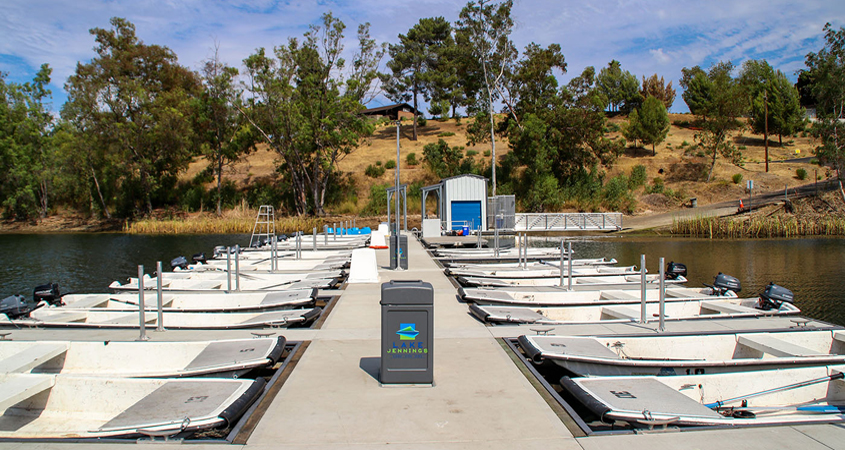
Visitors can use the Lake Jennings boat dock to rent motorboats, rowboats, kayaks, and paddleboats to explore the lake. The replacement dock is expected to last for generations to come. Photo: Helix Water District
“This project is a long-term investment in our lake operations and the community,” said Helix Water District board member and Parks, Land, Lakes, and Garden Committee Chair Dan McMillan. “This is a high-quality dock and it sets the standard for future improvements at the lake.”
The district’s board is in the early stages of evaluating improvements of similar quality at the lake’s campground.
Lake Jennings is one of two reservoirs owned by Helix Water District. It has a water storage capacity of 9,790 acre-feet and is open to the public for boating, fishing, camping, and hiking.
The lake is currently open on Fridays from 3 p.m. to midnight for night fishing, and for fishing and day-use on Saturdays and Sundays from 6 a.m. to 3 p.m. The campground – which boasts full-hookup, partial-hookup, non-hookup, and tipi sites – is open daily and accepting reservations. Further information, including COVID-19 safety requirements for visitors, is available: www.lakejennings.org.
Encinitas, Calif. — Olivenhain Municipal Water District’s Board of Directors voted unanimously at its August meeting not to raise water capacity fees in Fiscal Year 2021. After a comprehensive review, the board determined that current fees adequately cover OMWD’s planned capital expenditures through June 30, 2021.
Capacity fees are one-time charges to new development connecting to OMWD’s water system. Capacity fees are collected to fund necessary system expansion, replacement, and improvement projects to provide current and future ratepayers with a safe, reliable water supply.
The San Diego County Water Authority is partnering with the Scripps Institution of Oceanography at UC San Diego to better predict atmospheric rivers and improve water management before, during, and after those seasonal storms.
This month, Scripps’ Center for Western Weather and Water Extremes (CW3E) launched the Water Affiliates Group, which brings together cutting-edge science and hands-on water industry experience to enhance reservoir operations in light of the changing climate. The Water Authority has a long-running alliance with Scripps and is among six founding water agencies statewide.
CW3E and its partners will share and support best practices in forecast-informed reservoir operations, increase research around atmospheric rivers and droughts, and develop strategies for mitigating flood risk and increasing water supply reliability.
“This partnership with Scripps Institution of Oceanography underscores our commitment to strategic, science-based decision-making and long-term planning,” said Jim Madaffer, chair of the Water Authority’s Board of Directors. “By supporting advances in forecasting, we can more efficiently and effectively manage water resources both locally and statewide. This ultimately will benefit everyone in California by helping sustain our economy and quality of life.”
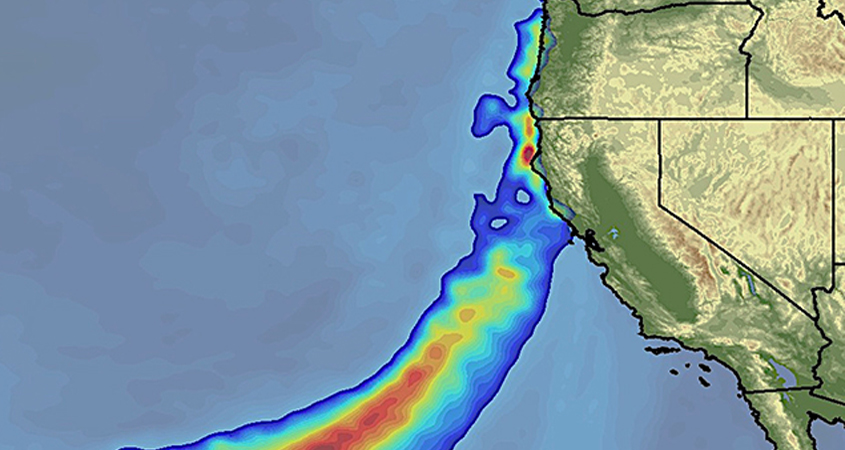
Atmospheric river storms cause 40% to 60% of annual precipitation and most of the flood damage on the West Coast. Graphic: Scripps Institution of Oceanography
Water Authority General Manager Sandra L. Kerl said the collaboration aligns closely with Governor Newsom’s Water Resilience Portfolio, which prioritizes voluntary agreements, smart water storage strategies and coordination of data collection.
“This is a great example of how water agencies are stronger together by addressing major climate challenges that affect everyone across the arid West,” Kerl said. “By combining forces with some of the leading scientists in the world, we will enhance our planning capacity and be ready to adapt to whatever the future brings.”
Atmospheric river storms cause 40% to 60% of annual precipitation and most of the flood damage on the West Coast. Managing reservoirs for both flood control and drinking water supply retention is challenging because 20th-century practices and regulations are decreasingly relevant due to changing patterns for snowmelt and rainfall.
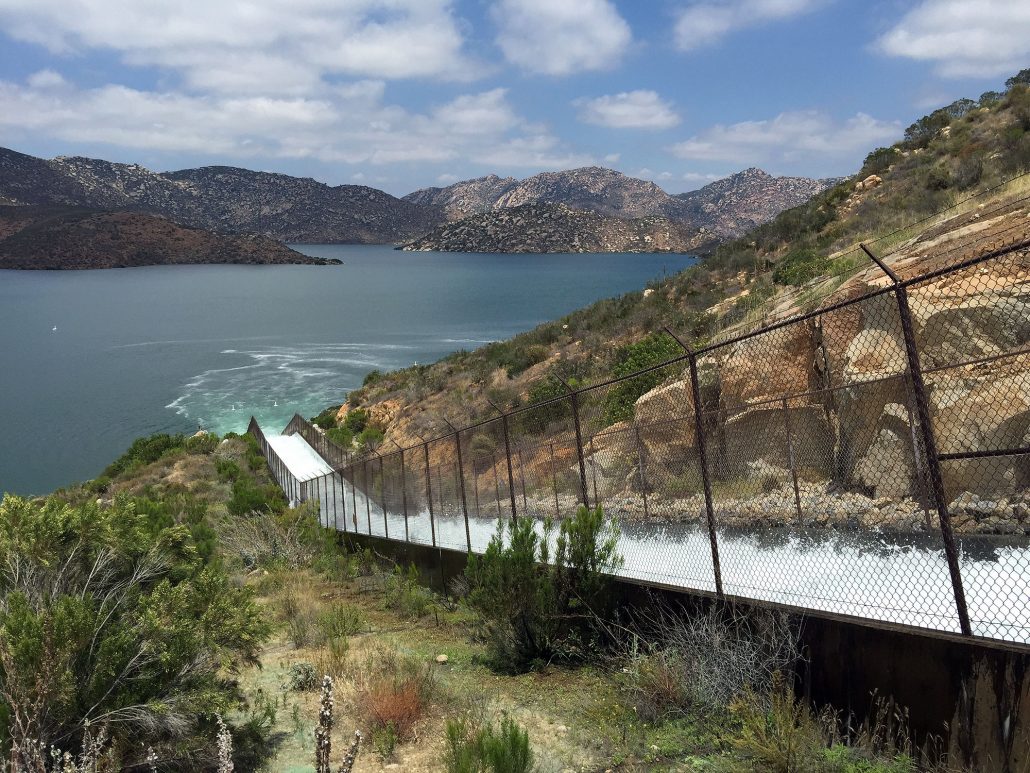
CW3E has numerous tools and technologies that affiliates can use to augment water research and improve on-the-ground decisions of water managers. Photo: San Diego County Water Authority
CW3E is a leader in Forecast Informed Reservoir Operations, which uses data from watershed monitoring and modern weather and water forecasting to help water managers determine the best strategies for retaining or releasing water from reservoirs. CW3E has numerous tools and technologies that affiliates can use to augment water research and improve on-the-ground decisions of water managers. The group’s research covers water supply reliability, flood management, greenhouse gas mitigation, groundwater recharge, public safety, observations, forecasting, decision support, climate outlooks, and hazard assessment.
The Water Authority is working with CW3E to assess how better near-term and long-term precipitation forecasts can improve reservoir planning and operational management in the San Diego region by maximizing local water supplies and the reliability of water resources through a mix of planning processes and real-time decisions.
Joining the Water Authority as founding partners are Sonoma Water, Orange County Water District, Yuba Water Agency, Turlock Irrigation District, and Irvine Ranch Water District.
The Vallecitos Water District is known for its sustainable practices in water and wastewater treatment processes, without any compromise in water quality. The district is now using a new ultrasound technology to address water quality at the Stanley A. Mahr Reservoir with a reduced need for chemical treatment.
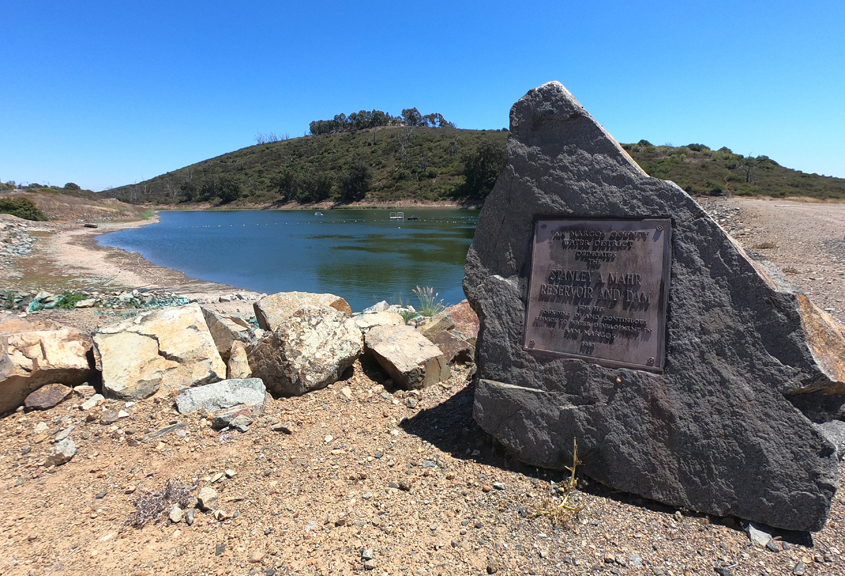
The Mahr Reservoir stores up to 54 million gallons of reclaimed water to be used later for irrigation. Photo: Vallecitos Water District
Mahr Reservoir was completed in 1981. Originally called La Costa Storage No. 1 Dam and Reservoir, it was renamed after the district’s original founder 35-year board member Stanley A. Mahr. It stores up to 54 million gallons of reclaimed water to be used later for irrigation. The district has contracts with the City of Carlsbad and Olivenhain Municipal Water District to provide water as needed, as much as five million gallons of recycled water daily.
Because the reservoir’s location receives intense sunlight with little rain, algal blooms can occur in the nutrient-rich recycled water. The most common method of treating algal blooms is with harmful chemicals. They are costly and labor-intensive.
The district instead uses technology developed by the international company LG Sonic, which provides a complete overview of the water quality allowing swift identification and treatment of algal blooms.
NOTE: Portions of this video were filmed in 2019, prior to the COVID-19 pandemic and any mandatory face covering requirements.
Every 10 minutes, an MPC Buoy in the Mahr Reservoir measures and monitors green and blue-green algae population, pH, turbidity, dissolved oxygen, and water temperature. The data is collected in real time and uploaded to a web-based software. The software uses the data to predict algal blooms three to ten days in advance.
The LG Sonic buoy can create a sound barrier in the top water layer, which affects the buoyancy of the algae, preventing it from rising up where it can absorb sunlight for photosynthesis to grow. Without sunlight and nutrients, algae cells sink to deeper water where they degrade due to natural bacteria and do not release toxins into the water.
With overall algae levels reduced by this technology, the need for chemical treatment is also reduced, allowing the Vallecitos Water District to provide high quality reclaimed water to its customers.
LG Sonic’s specific low power ultrasonic transmitters emit signals which are not harmful to people, fish, plants or other wildlife.
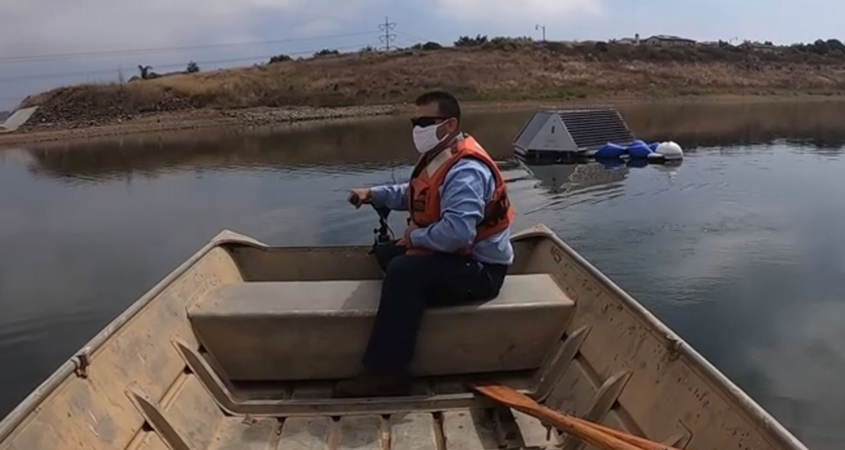
Meadowlark Water Reclamation Facility Wastewater Treatment Plant Operator II Ivan Murguia monitors water quality. Photo: Vallecitos Water District
After the initial installation, an unusual incident occurred. Electrical cords providing power to the reservoir’s water pumps became wrapped around the inlet/outlet pipes located underwater. Mahr’s algae meter needs water flow from the reservoir to be able to read the algae level.
Maintenance staff couldn’t untangle the power cords from above the water. Specialty divers were called in to address the problem. Vallecitos Pump and Motor Technician Dale Austin also had divers inspect pneumatic (air) and hydraulic (oil) lines to the motors (actuators) that open and close the inlet and outlet valves for leaks. Divers successfully untangled the electrical cords and they were secured to prevent future problems. Divers found no leaks on the lines.
Water agencies across San Diego County are doing their part to stabilize the state’s power grid during this week’s heatwave by generating hydropower and altering operations to trim electricity demands – and they are offering long-term solutions to reduce future energy shortages.
The California Independent System Operator issued a statewide Flex Alert from Sunday through Wednesday, calling for reduced electricity use in the afternoon and evening to limit power outages. Blackouts could affect hundreds of thousands of San Diego County residents, if extreme heat persists.
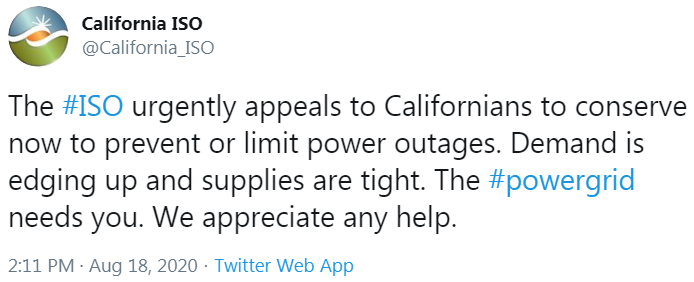
At Lake Hodges, the Water Authority is running its pumped energy storage facility to meet peak demands. As water flows down the pipeline from Olivenhain Reservoir into Lake Hodges, it generates up to 40 megawatts of energy on demand, helping to manage temporary peak electrical demands or unplanned outages. Then, the water is pumped back to Olivenhain Reservoir when power demands are low to restart the cycle.
In addition, water agencies are taking numerous actions to conserve energy. For the Water Authority, the strategy includes temporarily reducing drinking water production at the Claude “Bud” Lewis Carlsbad Desalination Plant in collaboration with Poseidon Water.
The Carlsbad Desalination Plant is the largest, most technologically advanced and energy-efficient desalination plant in the nation, and it has produced more than 62 billion gallons of drinking water for San Diego County since it began operations in December 2015.
Starting Monday, the plant ramped down operations, making an additional 8 megawatts of power available for other uses. If more load reductions are necessary over the next several days, additional curtailment may be considered at the plant. The power provided by the plant could help offset current energy shortages.
“This partnership by the Water Authority and Poseidon is another reminder of the value of the cutting-edge technology and local control at the Carlsbad plant,” said Jim Madaffer, chair of the Water Authority’s Board of Directors. “Operations are flexible and the technology is nimble, so production can be ramped up and down in response to local needs.”

In addition, local and regional water agencies are temporarily shutting down or reducing flows at pump stations and turning off HVAC systems in the afternoons. Some agencies also have the ability to convert to less energy-intensive treatment, for instance, by replacing ozone with chlorine.
Local water agencies also are tapping their significant backup power generation capacity – at their own expense – to ease the strain on the energy grid, following Governor Newsom’s executive order that suspends some regulatory requirements for those units during this emergency event. Local agencies are also looking to work with the administration to ensure that their backup generation capacity can be used proactively to help avoid future energy shortages.
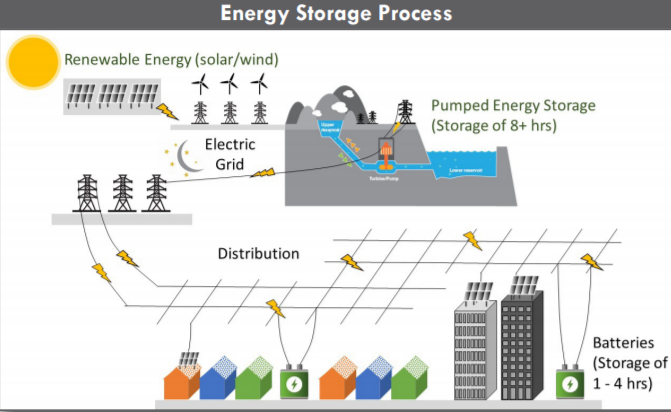
Pumped energy storage facilities are part of an integrated and sustainable energy system that
includes the production, storage and distribution of clean energy.
Beyond the immediate concerns, this week’s heat wave has highlighted the need to increase large-scale energy storage as the state moves toward a goal of 100% renewable energy by 2045. Put simply, the sun doesn’t always shine and the wind doesn’t always blow enough to meet demands, so the state needs more capacity to store peak renewable energy production for peak demand periods.
The Water Authority has proposed building a large-scale pumped storage project at the San Vicente Reservoir near Lakeside. Pumped energy storage projects are designed to store excess renewable energy from solar and wind when it’s available, and then discharge that energy when energy demands increase and renewable energy is scarce.
A 2019 white paper highlighted the importance of pumped energy storage to California’s future.
“Our current situation is the direct result insufficient planning; the state clearly needs additional energy storage now and will need much more in the future,” said Gary Bousquet, energy program manager for the Water Authority. “Environmentally friendly pumped storage projects should be started immediately to address this shortfall, or power reliability will get significantly worse. The San Vicente project can be started now at no cost to taxpayers – users only pay when the project comes online.”
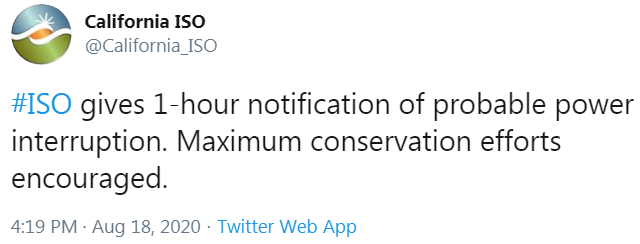
Carlsbad, Calif. (August 18, 2020) –To support statewide emergency energy conservation efforts, Poseidon Water and the San Diego County Water Authority are temporarily reducing water production at the Claude “Bud” Lewis Carlsbad Desalination Plant.
While the plant uses less than 1% of peak energy demand in San Diego Gas & Electric’s service territory, Poseidon and the Water Authority are committed to supporting electrical reliability while ensuring continued delivery of safe and reliable water supplies.
